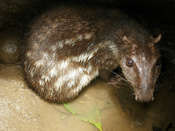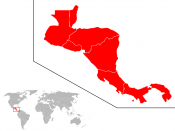Human habitation can be traced back more than 10,000 years but it appears Costa Rica was sparsely populated and a relative backwater in the pre-Columbian era. There is little sign of major communities and none of the impressive stone architecture that characterized the more advanced civilizations of Mesoamerica to the north and the Andes to the south. When Columbus arrived near Limâân on September 18, 1502 on his third and last voyage to the Americas, there were probably no more than 20,000 indigenous inhabitants They lived in several autonomous tribes, all with distinct cultures and customs. Costa Rica's only major archaeological site is at Guayabo, 30 miles east of San Jos'', where an ancient city, dating back to 1000 B.C. and though to have contained 10,000 people at its peak, is currently being excavated. Many interesting gold, jade and pottery artefacts have been found throughout the region and are on display in several museums in San Jose.
The Indians gave Columbus gold and he returned to Europe with reports of a plentiful supply of the yellow metal. But the adventurers who arrived to cash in found only hostile Indians, swamps and disease for their trouble. Several early attempts to colonize the Atlantic coast failed for the same reasons and for almost half a century Costa Rica was passed over while colonization gathered pace in countries to the north and south. In 1562, the Spanish main's administrative center in Guatemala sent Juan Vasquez de Coronado to Costa Rica as governor and Cartago was established as the capital the following year. With no Indian slaves to work the land, the colonists were forced to work the land themselves, scratching out a meagre subsistence by tilling small plots. The impoverished colony grew slowly and was virtually ignored by the Spanish rulers in Guatemala.


